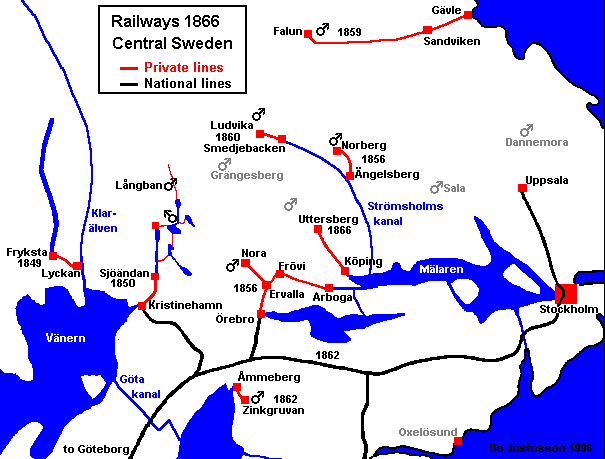
- Commercial traffic on Nora-Ervalla line ended in 1978 and it was made into a museum railway (see Tourist-page).
| Sweden 1850's | The first Swedish railways were built around 1850. Often to solve transportation problems for iron mines and iron works. Earlier transports were made in winter using horses and sledges on the frosen lakes. Large amounts of ore, iron, and charcoal were transported. Some channels had also been built, and some of the early railways were made as connections to them. (Map, 11kb GIF image) | |
|---|---|---|
| Railways 1866 | ||
 | ||
| 1. Frykstad railway (1849) Connecting Lake Fryken to river Klarälven (Lyckan loading place). 8 km, 1101 mm. First with horses, from 1856 with the steam loco Fryckstad (to-day at the Railway museum in Gävle). Closed in 1870 when the north-west national line reached the area. | 2. Kristinehamn-Sjöändan (1850) 11 km, 1099 mm. Connecting the Bergslag channel to Kristinehamn harbour. First with horses, and from 1868 with steam locos. This line was part of a network of lakes, small channels and small horse-powered railways in eastern Värmland. (One of them, the Kroppa railway, 1854, 787 mm, 9 km, got locos too in 1869). A larger line between Vänern (Kristinehamn) and Mora was built, and its first part was ready 1873, and the small lines were closed. | 3. Nora-Ervalla (1856) From the mines and
industries around Nora connecting to line 4. below
onto the harbours in Örebro (Skebäck) and Arboga.
1435 mm, Nora-Ervalla 17 km, extended to Otterbäcken harbour in 1876.
- Commercial traffic on Nora-Ervalla line ended in 1978 and it was made into a museum railway (see Tourist-page). |
| 4. Köping-Hult railway (1856) One idea was to build a railway between Lake Mälaren and Lake Vänern and link to boat transports, but this idea was soon abandoned. 1435 mm, Örebro- Ervalla (=Dylta) was ready in 1856, and to Arboga in 1857. The lines are still part of the national network. | 5. Norberg railway (1856) From the mines in Norberg to Engelsberg with iron works and harbour at Strömsholms channel, which connects to Lake Mälaren and the Baltic Sea. 17 km, 1188 mm. Converted to 1435 mm in 1876 and connected to the SWB line built from Västerås. In use to-day for some goods traffic. | 6. Gävle-Falun railway (1859) 91 km, 1435 mm. The first part Gävle-Kungsgården 32 km opened in 1857. The line goes from the copper mine in Falun to the harbour in Gävle. The line still exists. |
| 7. Wessman-Barken railway (1860) From Ludvika to Smedjebacken at the end of Strömsholms channel. 18 km, 1188 mm. It was replaced by a parallell standard gauge SWB-line in 1900, and closed completely in 1903. | 8. Zinkgruvan-Åmmeberg (1862) For transportation of zinc ore for the company Vielle Montaigne from the mine to a harbour, and then by ship through the Göta kanal channel. Closed 1975. Their first loco Carlsund (1862) is now at the railway museum in Gävle. | 9. Köping-Uttersberg railway (1866) From industries in Uttersberg to the harbour in Köping (Lake Mälaren). Extended to the mine in Riddarhyttan in 1880. 57 km, 1093 mm (unique!). The line closed in 1967. It was long one of the most old-fashioned lines in Sweden. |